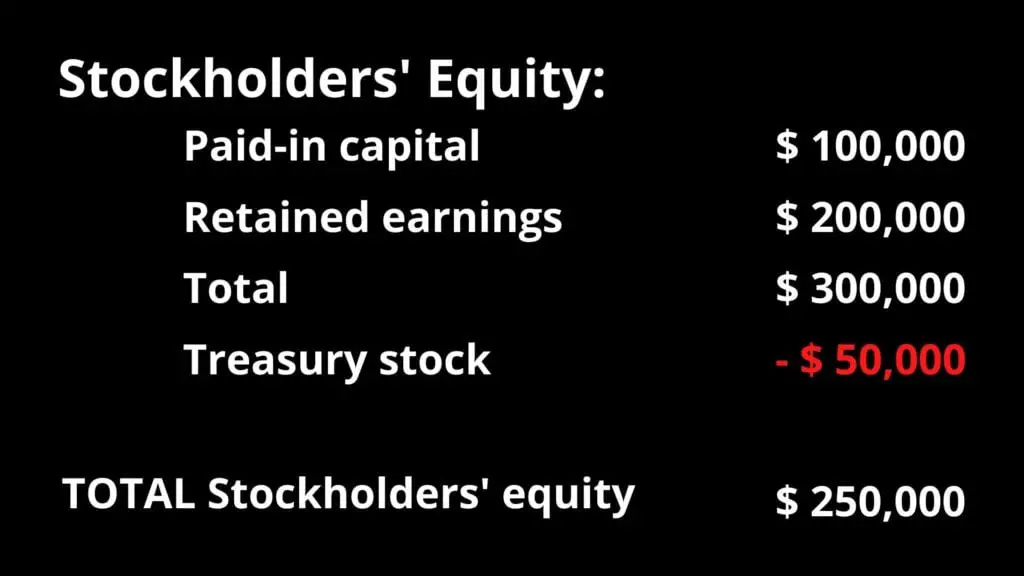Negative treasury stock is the normal way of accounting for treasury shares on the balance sheet. According to GAAP, the treasury stock is a contra account in the shareholders’ equity section of the balance sheet. When a company decides to repurchase its issued shares, the repurchased shares must be accounted for. To find out more about what it means to have negative treasury stocks, how companies account for treasury shares, and the reasons why they repurchase their shares, read on.
What is a Negative Treasury Stock?
When a company sees the need to buy back some of its shares, some form of cash or debt is used to purchase the stocks from the outstanding shares available. When these outstanding shares are repurchased, they are known as treasury stocks, treasury shares, reacquired shares, common stock repurchased or reacquired stocks. These treasury shares are not the same as common outstanding shares because they do not earn dividends for the company and they don’t give voting rights to the company. There are reasons why companies have treasury shares (see below). The treasury stocks that were repurchased must be accounted for in the balance sheet.
Accounting for treasury shares on the balance sheet must be done under the shareowners’ equity section (according to the GAAP). Because treasury stocks reduce the shareholders’ equity, it is indicated as negative on the balance sheet. Therefore, a negative treasury share or negative treasury stock simply means the shareholders’ equity has been reduced; it would therefore be subtracted from the total shareowners’ equity as indicated in the picture below.

Another reason for negative treasury stock is that the treasury stock account is a contra account to the shareholders’ equity account and therefore must be indicated with a negative sign when it is reported on the balance sheet under the equity section.
A negative treasury share does not in any way mean that a company is in trouble or that it has no stocks available. It is just a way to account for the treasury stocks that were repurchased.
Reasons for having treasury stocks
- The company was to prevent a hostile takeover from an investor; buying back the shares reduces the number of shares available to gain a controlling interest in the company.
- Treasury stocks can be used by the company to compensate the employees
- A company may buy back shares when it thinks the stocks are undervalued by the open market.
- When a corporation wants to go private, it repurchases all the outstanding shares.
Retired Stock (Canceled Shares)
Retired stocks are types of shares that a company repurchased from its own outstanding shares but instead of keeping them to resell later, they have been canceled; therefore, retired stocks are also known as canceled stocks. They are different from treasury shares because treasury stocks can be resold but retired stocks cannot be resold.
FAQs
Why are treasury shares subtracted from the shareholders’ equity on the balance sheet?
Treasury shares are purchased with cash from the retained earning account. Since the retained earning account is part of the shareowners’ equity, any cash removed or subtracted from the retained earnings must be accounted for; therefore, a reduction of cash from retained earnings to pay for treasury stock must be subtracted from the total equity of shareowners. This is indicated on the balance sheet with a negative treasury stock.
Why would a company not buy treasury stock?
It is not mandatory for companies to repurchase their stocks unless they see the need to buy back their shares. There are many reasons why a company may decide to have treasury stocks, some of the reasons are that the company thinks its stocks are undervalued, the company wants to prevent a takeover, or it wants to use the treasury stock to compensate employees. If all these reasons for buying treasury stocks are not important for a company, then it has no need to have treasury stocks.
Nansel is a serial entrepreneur and financial expert with 7+ years as a business analyst. He has a liking for marketing which he regards as an important part of business success.
He lives in Plateau State, Nigeria with his wife, Joyce, and daughter, Anael.
